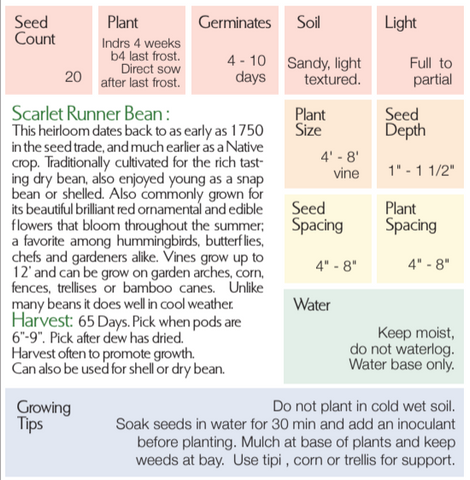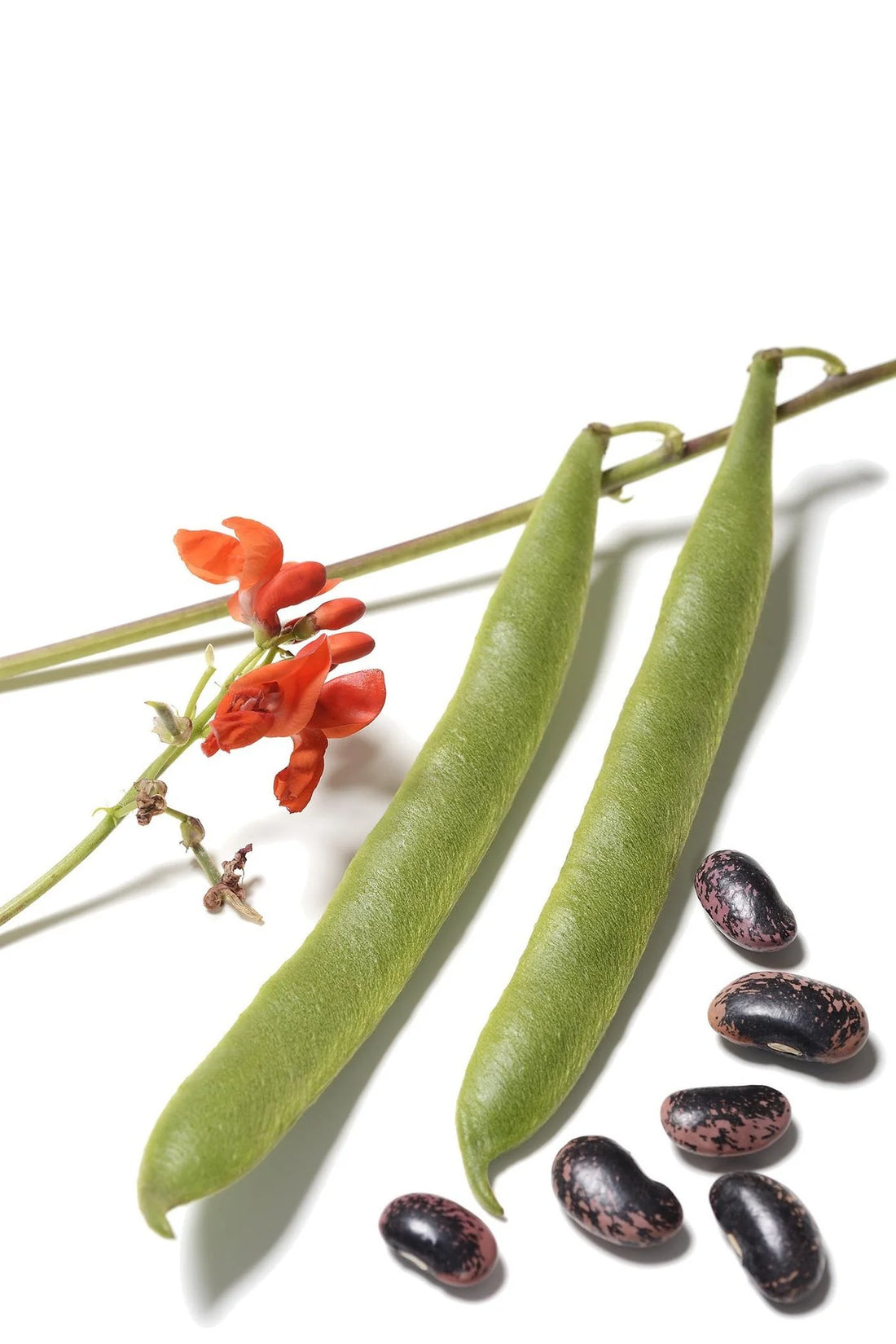Scarlet Runner Bean - Phaseolus coccineus
Organic Scarlet Runner Bean Seeds
This heirloom variety dates back to as early as 1750 in the seed trade and much earlier as a Native crop. A versatile plant that offers a use in every stage of its life. Traditionally cultivated for the rich tasting dry bean, this unique looking variety is also enjoyed young as a snap bean or shelled. The seeds begin green, slowly turn bright pink, then specked dark red as they mature. The Scarlet Runner is also commonly grown for its beautiful brilliant red ornamental and edible flowers that bloom throughout the summer; a favorite among hummingbirds, butterflies, chefs and gardeners alike. Picking the flowers for use, promotes continual flowering.
With vines growing up to 12’, this spirited bean can be grow on garden arches, corn, fences, trellises or bamboo canes. Unlike many beans it does well in cool weather.
- Non-GMO
- Annual
- Sun: Full to partial
- Indoors: 4 weeks before last frost
- Direct Sow: After last frost
- Seed Count: 20
- Days to Maturity: 65
- Plant Size: 4'-8' vine
Growing Tips:
Do not plant in cold wet soil. Soak seeds in water for 30 minutes and add an inoculant before planting. Mulch at base of plants and keep weeds at bay. Use tipi, corn, or trellis for support.
When starting seeds indoors, it is key that your new starts be hardened off. This is a process that requires taking them outside during the day, for a period of time, before they are planted. This acclimates your seedlings to the outside world, meaning the elements like the wind and sun. We do it for several weeks to a month as this strengthens their stems and overall plant structure.
- Start for a short period of time initially, then graduate to more time each day
- One week minimum is recommended
- Bring them inside in the early evening and overnight
- Keep an eye on them and constantly water them. Make sure they have not blown over.

This content type will accept rich text to help with adding styles and links to additional pages or content. Use this to add supplementary information to help your buyers.
You can use product metafields to assign content to this tab that is unique to an individual product. Use tabs to highlight unique features, sizing information, or other sales information.
Organic Scarlet Runner Bean Seeds
This heirloom variety dates back to as early as 1750 in the seed trade and much earlier as a Native crop. A versatile plant that offers a use in every stage of its life. Traditionally cultivated for the rich tasting dry bean, this unique looking variety is also enjoyed young as a snap bean or shelled. The seeds begin green, slowly turn bright pink, then specked dark red as they mature. The Scarlet Runner is also commonly grown for its beautiful brilliant red ornamental and edible flowers that bloom throughout the summer; a favorite among hummingbirds, butterflies, chefs and gardeners alike. Picking the flowers for use, promotes continual flowering.
With vines growing up to 12’, this spirited bean can be grow on garden arches, corn, fences, trellises or bamboo canes. Unlike many beans it does well in cool weather.
- Non-GMO
- Annual
- Sun: Full to partial
- Indoors: 4 weeks before last frost
- Direct Sow: After last frost
- Seed Count: 20
- Days to Maturity: 65
- Plant Size: 4'-8' vine
Growing Tips:
Do not plant in cold wet soil. Soak seeds in water for 30 minutes and add an inoculant before planting. Mulch at base of plants and keep weeds at bay. Use tipi, corn, or trellis for support.
When starting seeds indoors, it is key that your new starts be hardened off. This is a process that requires taking them outside during the day, for a period of time, before they are planted. This acclimates your seedlings to the outside world, meaning the elements like the wind and sun. We do it for several weeks to a month as this strengthens their stems and overall plant structure.
- Start for a short period of time initially, then graduate to more time each day
- One week minimum is recommended
- Bring them inside in the early evening and overnight
- Keep an eye on them and constantly water them. Make sure they have not blown over.


